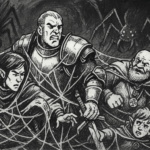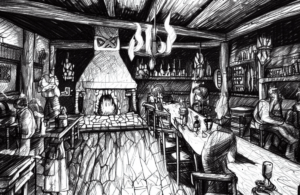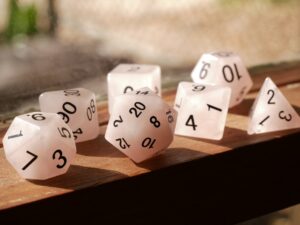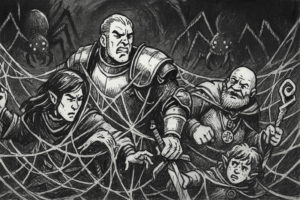What Is Damage Resistance (DR)?
Damage Resistance, or DR, is a simple rule that makes really tough enemies or vehicles (like dragons or airships) harder to hurt with ordinary attacks. Think of DR as super-tough armor: small hits bounce off, but big weapons or special tricks can break through.
Imagine trying to scratch a stone castle wall with a dinner knife versus hitting it with a sledgehammer. The knife won’t do much, but the sledgehammer will chip away chunks. DR works the same way—it represents things that are just too tough for normal weapons to hurt effectively.
How Does DR Work?
When you attack something with DR, you subtract a set number (its DR) from the damage you roll. If the DR is higher than your damage, your attack doesn’t hurt it at all.
Step-by-Step Process:
- Roll your attack to see if you hit
- Roll your damage if the attack succeeds
- Subtract the target’s DR from your damage
- Apply the remaining damage (minimum 0)
Basic Examples:
- Scenario 1: An ancient stone golem has DR 8. You hit it with your sword for 5 damage. Since 5 is less than 8, you subtract all 5 damage. The golem takes 0 damage—your blade just sparks off its rocky hide.
- Scenario 2: You hit the same golem for 12 damage. You subtract 8 for the DR (12 – 8 = 4), so the golem takes 4 damage. You’ve managed to chip off some stone!
- Scenario 3: An iron-plated war machine has DR 15. Your regular bow shot does 9 damage, but after DR, it deals 0 damage. However, your friend’s enchanted crossbow bolt does 18 damage and ignores DR entirely, dealing the full 18 damage!
What Attacks Ignore DR?
Some attacks are powerful enough to ignore DR and do their full damage. When an attack ignores DR, you skip the subtraction step entirely—just deal your full damage roll.
Common DR-Ignoring Attacks:
- Siege weapons (like ballistae, cannons, catapults, or bombards)
- Powerful spells (like fireball, lightning bolt, or meteor strike)
- Magic weapons (swords, arrows, or other gear that’s been enchanted)
- Special equipment (items made specifically to fight that type of foe)
- Called shots to weak points (when the GM allows it)
- Critical hits (in some campaigns—check with your GM)
Why These Work:
- Siege weapons are built to punch through fortress walls and ship hulls
- Magic spells bypass physical toughness with supernatural force
- Enchanted weapons cut through mundane defenses like a hot knife through butter
- Specialized gear exploits known weaknesses (like silver weapons against certain monsters)
Extended Examples in Play
The Iron Fortress Scenario:
Your party faces a massive mechanical fortress with DR 12. Here’s how different attacks play out:
| Attack Type | Damage Rolled | DR Applies? | Calculation | Actual Damage | Player Experience |
|---|---|---|---|---|---|
| Fighter’s longsword | 8 | Yes | 8 – 12 = 0 | 0 | “Your blade scrapes harmlessly across the metal plating.” |
| Rogue’s crossbow | 11 | Yes | 11 – 12 = 0 | 0 | “The bolt bounces off with a metallic ping.” |
| Siege ballista | 20 | No | No subtraction | 20 | “The massive bolt punches clean through the armor plating!” |
| Wizard’s fireball | 18 | No | No subtraction | 18 | “Magical flames engulf the construct, melting joints and gears!” |
| Fighter’s +2 magic sword | 14 | No | No subtraction | 14 | “Your enchanted blade glows as it bites deep into the metal!” |
| Ranger’s regular arrow | 15 | Yes | 15 – 12 = 3 | 3 | “Your expert shot finds a gap in the plating.” |
The Ancient Dragon Scenario:
A legendary red dragon has DR 18 and magical hide. Here’s what happens:
Round 1:
- Barbarian charges with greataxe: Rolls 16 damage. 16 – 18 = 0 damage. “Your axe bounces off scales harder than steel!”
- Wizard casts Magic Missile: Deals 12 damage, ignores DR. Full 12 damage! “Glowing darts of force pierce through the dragon’s magical defenses!”
Round 2:
- Ranger with +3 enchanted bow: Rolls 19 damage, ignores DR. Full 19 damage! “Your magical arrow finds a gap between scales!”
- Cleric with regular mace: Rolls 8 damage. 8 – 18 = 0 damage. “The dragon’s hide is too thick for normal weapons!”
Advanced DR Concepts
Partial DR Bypass
Some GMs might rule that certain attacks partially ignore DR:
- Masterwork weapons might reduce DR by half
- Adamantine weapons might ignore the first 5 points of DR
- Two-handed weapons might get +2 to damage before DR is applied
Multiple DR Types
Tougher enemies might have different types of DR:
- DR 10/Magic means normal weapons subtract 10, but magic weapons ignore it entirely
- DR 5/Silver means all weapons subtract 5 except silver ones
- DR 15/Siege means only siege weapons ignore the DR
Environmental DR
Sometimes the environment itself has DR:
- Castle walls might have DR 20, making them nearly immune to personal weapons
- Ship hulls could have DR 8, requiring special tactics in naval combat
- Magical barriers might have DR that only certain spell types can bypass
Player Strategy Guide
When Facing High DR Enemies:
Before Combat:
- Scout and plan: Learn what kind of DR your enemy has
- Gear up properly: Bring magic weapons, special ammunition, or siege equipment
- Coordinate spells: Save your big damage spells for DR enemies
- Research weaknesses: Some creatures have specific vulnerabilities
During Combat:
- Focus fire: Have DR-ignoring attackers target the tough enemy while others handle minions
- Support the heavy hitters: Use buffs, flanking, or other tactics to help your siege weapons and spellcasters
- Look for opportunities: Ask your GM about weak spots, environmental hazards, or creative solutions
- Don’t panic: Even 1-2 points of damage per round will eventually wear down any enemy
Smart Tactical Choices:
- The Wizard’s Moment: Save your big damage spells for the DR enemies—this is when magic truly shines
- The Fighter’s Adaptation: Invest in magic weapons early, or learn to use siege equipment
- The Rogue’s Creativity: Look for alternate win conditions—maybe you can disable the enemy instead of destroying it
- The Cleric’s Support: Buff your allies’ weapons with magic, or heal while others do the heavy lifting
Common New Player Questions
Q: “Can I ever hurt a high-DR enemy with normal weapons?” A: Yes! If you roll damage higher than the DR, you’ll chip away at it slowly. A DR 10 enemy can still be hurt by a sword that rolls 12 damage—it just takes patience.
Q: “What if I can’t afford magic weapons yet?” A: Look for creative solutions! Find environmental hazards, work with your team to set up siege weapons, or focus on enemies you can hurt while your spellcasters handle the tough ones.
Q: “Does DR apply to healing spells?” A: No! DR only applies to damage. Healing, buffs, and other beneficial effects work normally.
Q: “What about damage over time, like poison or fire?” A: Usually, DR applies to each instance of damage. So if you’re taking 5 fire damage per round and have DR 3, you’d only take 2 fire damage each round. Check with your GM!
Why Use DR?
DR makes legendary monsters, huge machines, and epic encounters feel appropriately challenging and cinematic. It ensures that:
- Ordinary tactics won’t work against extraordinary foes
- Players must be creative and use the right tools for the job
- Teamwork becomes essential as different party members contribute different solutions
- Magic feels special by providing clear advantages over mundane attacks
- Boss fights feel epic rather than just being hit point sponges
- The world feels realistic where a knight’s sword realistically can’t easily damage a stone giant
Cinematic Moments and GM Guidance
Creating Drama:
The GM might allow special circumstances to bypass DR:
- “You notice a crack in the golem’s chest where you can strike!” (Called shot opportunity)
- “The dragon roars in pain, exposing the soft flesh of its throat!” (Critical hit opening)
- “Working together, you manage to hold the creature still for your ally’s siege weapon!” (Teamwork bonus)
- “Your knowledge of ancient warfare reveals this construct’s weakness to lightning!” (Knowledge check reward)
Describing DR in Action:
Instead of just saying “You deal 0 damage,” try:
- For 0 damage: “Your weapon skitters across the armored hide, leaving only scratches”
- For reduced damage: “You find a gap in the plating, but most of your force is absorbed”
- For DR-ignoring attacks: “Your magical blade cuts deep, the enchantment flaring as it bites into the creature’s flesh”
Summary for New Players
The Simple Version:
- Check if your attack is special (magic, siege weapon, spell, etc.)
- If it’s not special: Subtract the enemy’s DR from your damage
- If it is special: Deal full damage—no subtraction
- DR can’t make damage negative: 0 is the minimum
- When in doubt: Ask your GM if your weapon or spell ignores DR
Quick Reference:
- Normal attacks: Damage minus DR (minimum 0)
- Magic weapons: Usually ignore DR
- Spells: Usually ignore DR
- Siege weapons: Always ignore DR
- Creative solutions: Might ignore DR (GM’s call)
The Golden Rule:
If your sword bounces off a dragon’s scales, try a ballista, cast a fireball, or get creative—there’s always a way to win!
Designer’s Note
DR isn’t meant to make enemies invincible—it’s meant to make players think tactically and feel awesome when they find the right solution. A well-placed fireball or perfectly aimed ballista shot should feel like a moment of triumph, not just another dice roll. Encourage creativity, reward smart planning, and remember that the most memorable battles are the ones where players have to adapt and overcome seemingly impossible odds.
Monster List with Damage Resistance Applied
High DR (10-20+)
Dragons (All Types)
- Why: Legendary creatures with thick, magical scales that are harder than steel. Their hide is literally described in most fantasy as deflecting ordinary weapons.
- Suggested DR: 12-18 depending on age/color
Giants (Hill & Stone)
- Why: Massive humanoids with incredibly thick skin and dense bone structure. Stone Giants especially would have rock-hard skin.
- Suggested DR: Hill Giant DR 8, Stone Giant DR 12
Treant
- Why: Living trees with bark harder than most armor. Axes and swords wouldn’t do much against something that’s essentially a walking oak tree.
- Suggested DR: 15
Medium DR (5-12)
Tyrannosaurus Rex
- Why: Apex predator with incredibly thick hide and massive bone density. Regular weapons would struggle against something this naturally armored.
- Suggested DR: 10
Ankylosaurus & Triceratops
- Why: Heavily armored dinosaurs with natural bone plating and thick hides designed to deflect predator attacks.
- Suggested DR: Ankylosaurus DR 12, Triceratops DR 8
Mammoth
- Why: Massive creature with extremely thick hide and dense fat layers that would absorb most weapon strikes.
- Suggested DR: 8
Gargoyle
- Why: Made of animated stone. Regular weapons would chip at best.
- Suggested DR: 10
Living Statue
- Why: Literally made of stone or metal. Physical weapons would be largely ineffective.
- Suggested DR: 12
Roc
- Why: Legendary giant bird with feathers tough enough to deflect arrows and thick enough skin to resist normal weapons.
- Suggested DR: 8
Low DR (3-8)
Elementals (All Types)
- Why: Beings of pure elemental matter. Earth elementals are living rock, while others have supernatural resilience.
- Suggested DR: Earth DR 8, others DR 5
Troll
- Why: Legendary regenerating creatures with tough, rubbery hide that’s famously difficult to cut.
- Suggested DR: 6
Rust Monster
- Why: Chitinous exoskeleton that’s specifically evolved to be weapon-resistant (since it eats metal).
- Suggested DR: 5
Owlbear
- Why: Magical beast with incredibly thick fur and hide, making it naturally resistant to light weapons.
- Suggested DR: 4
Cave Bear
- Why: Massive bear with extremely thick fur and hide layers. Much tougher than regular bears.
- Suggested DR: 5
Minotaur
- Why: Legendary creature with supernaturally tough hide and dense muscle mass.
- Suggested DR: 5
Design Philosophy:
I focused on creatures that are either:
- Naturally armored (dinosaurs with bone plates, thick-skinned megafauna)
- Made of tough materials (stone creatures, elementals)
- Legendary/magical toughness (dragons, treants, trolls)
- Massive size with corresponding durability (giants, T-Rex, mammoth)
I avoided giving DR to creatures that are dangerous due to speed, numbers, special abilities, or magical powers rather than physical toughness. For example, vampires and liches are dangerous due to magic, not thick skin, so regular weapons should still hurt them normally.
This creates clear tactical decisions: bring siege weapons for dragons and giants, but your regular sword will work fine against undead wizards and swift predators.
Discover more from Cresthaven RPG
Subscribe to get the latest posts sent to your email.















